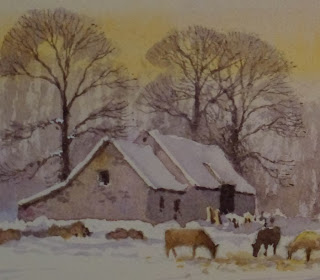Our recent trip to Scotland and subsequent workload have alas, inhibited new blog posts, as so much seems to be happening at once. Jenny and I experienced a glorious period of sunny weather in the Highlands, making for some really marvellous sketching experiences on the Fife coast and in the Cairngorm mountains. Fife has some lovely harbours that make for great painting compositions, and is a place I’ve missed out in the past because of my headlong rush always to get into the Highlands. It also gave us great pleasure to meet so many of our Scottish friends, a great many of whom turned up for my demonstration at the Pitlochry Festival Theatre.

This post’s illustration continues the Scottish theme, showing a part of a watercolour of a loch where a promontory is coming in from the left side. So often we see these features as a dark mass set against lighter water. Before you begin work on this consider how you might tackle it in terms of values. In this example I have painted in the promontory so that the top edge stands dark and hard against the light water of the loch, while the bottom edge is light and soft, and in fact lost altogether in places.
This approach avoids the promontory appearing to be cut out and stuck in place, setting it into the composition in a more natural way. Note also how I’ve dropped in a variety of colours in the lower edge, including permanent alizarin crimson and yellow ochre. Of course, these techniques can be applied to many situations and features in a painting, so give it a try. The illustration is part of a painting that is featured in my exhibition at the John Muir Trust Wild Space Gallery in Station Road, Pitlochry, until 18th June – telephone 01796 470080 or check my website
The one fly-in-the-ointment of our Scottish trip was the vast swathes of wind turbines now springing up all over the place, even encroaching on the stunning scenery of the Highlands themselves. If this continues it will totally destroy the reputation of Scotland for it’s outstanding and world-renowned scenery, and what to me is a truly tragic and criminal act simply aimed at vast profits for the energy corporations, and absolutely nothing to do with preserving the environment. I was so badly affected that for the first two nights there I could not sleep.


